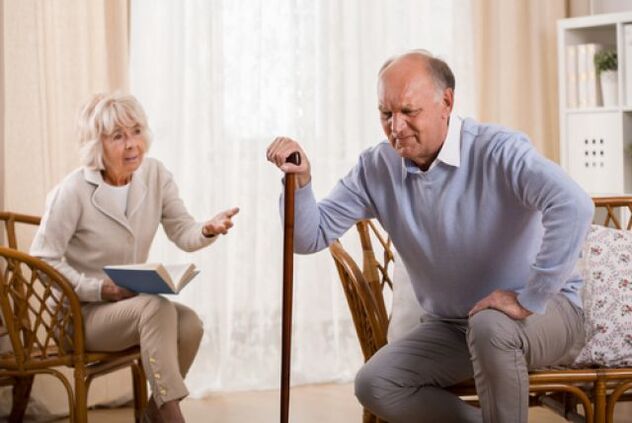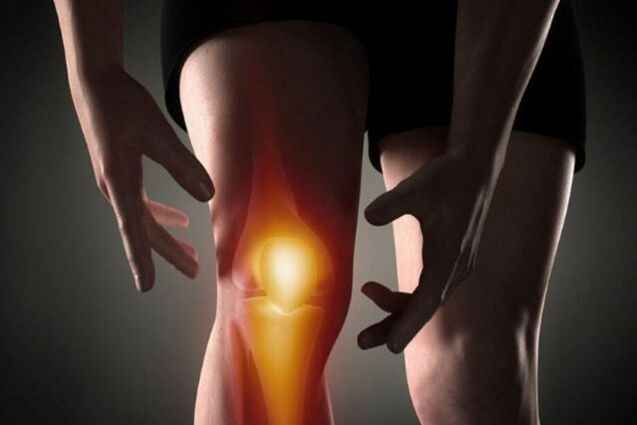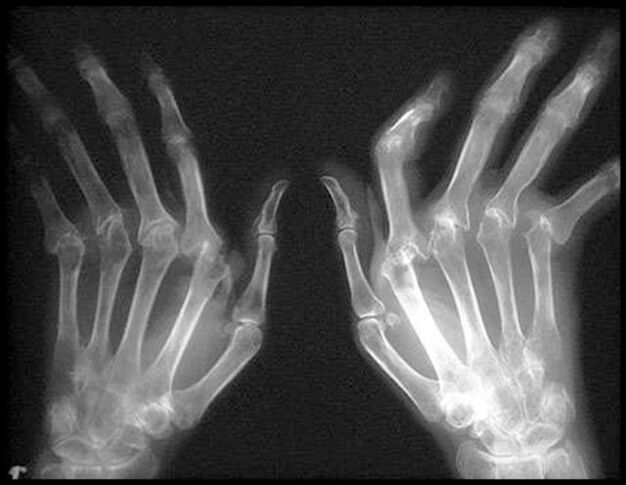
There are many articulations pathologies, vary according to the origin, development mechanism, symptoms and treatment methods.Most of the time, among others, arthritis and osteoarthritis are diagnosed.Diseases are similar, but they have some important differences.Differential diagnosis is necessary for the correct selection of timely therapy and prevention of serious complications.To avoid misunderstandings and confusion, you must discover how osteoarthritis differs and what are both ailments.
What is arthritis and osteoarthritis, how do they differ?
Arthritis, osteoarthritis: two different diseases that affect the joints.Despite the consonance of the terms, this is not the same diagnosis, and even more the synonyms.They have general and diverse signs, so they should not be confused.
Arthrosis is a degenerative-disapófic joint pathology, which is characteristic of:
- Damage to the cartilage tissue with the gradual participation of ligaments, muscles, synovial shell, bones in the destructive process;
- non -inflammatory character;
- Chronic course of the course;
- It develops locally, without affecting the body as a whole.
Arthrosis occurs mainly in adulthood, after 45 years, in women in the context of body aging, wear of the musculoskeletal system.Occasionally it appears in younger ones due to significant physical effort, heavy injuries, adverse working conditions.According to the international classifier, MKB-10, an M15-M19 code is assigned.
Arthritis is a collective term that includes joint diseases:
- It is inflammatory;
- It continues more often acutely, becoming chronic;
- It affects bone tissue and joint cavity;
- It occurs as a systemic lesion, with the participation of several joint compounds and objective organs at the same time in the pathological process.
Adults under 40, as well as children, are subject to arthritis.The disease is reversible, treated successfully subject to medical help for timely search.According to the classifier, ICD-10 has a M00-14 code.
Arthritic and arthrose pathologies are often interconnected.Incover arthritis with age leads to distributing changes in the cartilage.In turn, osteoarthritis during periods of exacerbation is accompanied by tissue inflammation.A joint ailment is called arthritis arthritis.

Types of diseases
Arthritis in the official medical classification is divided into species according to several criteria.Depending on the form, acute (severe inflammation, susceptible to complete healing) and chronic (incurable pathology with exacerbations).According to the degree of damage to the joints, there is monoarthritis (in an articulation), oligo -arthritis (in 2-3 joints), polyartitis (multiple inflammation).
The most popular arthritis classifier is considered according to the origin:
- Rheumatoid: The root cause is found in genetic disorders of an autoimmune nature;
- Infectious (septic): the development of pathogenic microflora directly in the joint cavity;
- Reactive: Secondary complication of respiratory, genitourinary and intestinal infections;
- Traumatic (post -traumatic) is formed due to mechanical damage to bones, tendons, muscles, ligaments;
- Exchange (GOUTY) - Violation of metabolic processes in the body;
- Rheumatic: It develops after a bacterial infection in the body.
Arthrosis is characterized by an exclusively chronic form with damage to an articular compound.It mainly affects mobile joints in the human body: legs (knee, ankle, foot), hands (shoulder, elbow), as well as the areas of the jaw and vertebral.
Depending on the location, it is divided into:
- knee (gonarrosis);
- hip (co -karstrosis);
- ankle;
- brachial;
- elbow;
- hands;
- leg thumb;
- spine (spondilartrosis);
- cervical (unkwertbral);
- Notable landing (virtual machines).
The therapy depends largely on the type of joint pathology, especially arthritis.
The difference in the causes of arthritis and osteoarthritis
Arthritis and osteoarthritis occur in the context of many adverse factors.The common provocaters of both diseases are:
- genetic predisposition;
- lesions (bruises, dislocations, subluxation, stretching, fractures);
- congenital anomalies in the development of the musculoskeletal system;
- metabolic and hormonal disorders;
- Serious chronic diseases (rheumatism, tuberculosis, diabetes mellitus, thyroid problems);
- inappropriate lifestyle (low activity, poor nutrition, overweight, bad habits);
- Significant physical and emotional loads.
The listed deviations affect the body as a whole, which significantly increases the risk of joint ailment.But there are more direct and obvious causes of each disease separately.
Of great importance in the development of the arthritis game:

- Infections of viral, fungal and bacterial origin (influenza, salmonellosis, hepatitis, tonsillitis, intestinal infection, borrell, syphilis);
- Autoimmune pathologies (psoriasis, multiple sclerosis, red lupus);
- Metabolic violation (gout);
- Bone diseases (osteoporosis, osteomyelitis, osteochondrosis, osteoarthrosis);
- allergic reactions;
- low immunity;
- Surgical operations in the joints.
The impetus for the appearance of pathology can be banal hypothermia, bad health conditions, an unbalanced diet.
What is the difference between osteoarthritis and arthritis?Degenerative changes in cartilage for osteoarthritis, in addition to the common causes listed, occur for reasons:
- disorders related to the age of the functionality of the musculoskeletal system;
- inflammatory process not used in joints (arthritis, synovitis);
- Poor blood circulation (atherosclerosis, varicose);
- Professional activities (athletes).
Typically, joint pathology is the result of several internal and external adverse factors at the same time.

The difference between arthritis and osteoarthritis in symptoms
The symptoms of two diseases in general manifestations are quite similar.The inflammatory and non -inflammatory damage of the joints is characterized by:
- pain of different intensity;
- a feeling of rigidity and rigidity;
- Crunch and crunch while walking;
- discomfort after prolonged rest;
- Painful reaction to climatic changes, physical activity;
- External deformation of the affected area.
At the same time, the nature and time of the appearance of unpleasant sensations, the severity and intensity of the pathological process differ significantly.
According to these signs, you can understand what the disease is in front of you: arthritis, osteoarthritis, what is the difference between them:
- Pain for arthritis occurs suddenly in the context of relative health, with osteoarthritis, gradually increases as distributed changes in cartilage advance, from a couple of months to several years;
- Arthritis is bother painfully in the hours of night and in the morning, decreases after the development of the joints, the pain of osteoarthritis, on the contrary, decreases at rest and increases significantly when moving (in the last stage it is constantly present);
- Arthritis is always accompanied by an inflammatory process with swelling, redness, hyperemia, local temperature increase, for osteoarthritis, such a course is characteristic only during periods of exacerbations;
- Arthritis is systematic, which involves the left and right joints of the legs or arms in the process at the same time, in addition to affecting the heart, light, skin, vessels, nervous system.Arthrosa lesion generally does not go beyond a pathological joint;
- In the initial stages, the appearance is distinguished: with arthritis, the inflammation of the tissues is clearly visible, the place is swollen and heats up, with osteoarthritis there are no visual changes, and only in advanced cases of both diseases the joint deformation is manifested;
- The general good with arthritis worsens: the temperature increases, there is weakness, discomfort, appetite disappears, the weight is reduced (chronicly, this sign may be absent).Such symptoms do not bother patients with osteoarthritis, just a painful and bad joint that works is in the center of care.

In different stages of the disease, the clinical image can vary significantly.It is possible to make a precise diagnosis only after a complete exam.
Differential diagnosis of osteoarthritis and arthritis
In the first signs of joint disease, it is necessary to register for a consultation with a doctor.An arthrologist is dedicated to such pathologies, which knows exactly how to recognize arthritis and osteoarthritis and what is its difference.If there is no such specialist in the clinic, you can visit an orthopedist, traumatologist, osteopath, rheumatologist, surgeon.With arthritis, depending on the etiology of the disease, you may need an additional consultation of an infectious disease specialist, immunologist, neuropathologist, endocrinologist, cardiologist.
On the basis of confrontation and initial diagnosis, it is difficult to make a precise diagnosis.
A series of instrumental investigations are required:
- Radiography to determine the condition of the joints, recognition of injuries, neoplasms;
- CT and MRI for detailed consideration not only of the joint cavities, but also of soft tissues;
- Ultrasound: It is carried out if there are contraindications for X -rays and tomography.
All these methods are quite informative, applicable to both pathologies.

If arthritis is suspected, you cannot do without laboratory tests that allow you to identify the root cause of the disease and determine the general condition of the body:
- Blood analysis for the level of leukocytes, ESR, specific markers;
- urine analysis for uric acid salts;
- rheumatic tests to detect a rheumatoid factor;
- Immune test to evaluate the body's immune defense state;
- PCR diagnosis in the pathogen of infection;
- Arthroscopy for synovial fluid fence for analysis.
A set of methods is selected individually on the basis of a clinical image and a preliminary inspection of a specialist.A complete test does not take long, but it is very important to make a differential diagnosis and prescribe proper treatment.
The difference and characteristics in the treatment of each disease
Both ailments imply special therapy, without which arthritis goes to a chronic form, and osteoarthritis deprives performance.
The general principles of treatment are similar, but the tasks are different:
- With arthritis, the main objective is to relieve inflammation, eliminate painful symptoms, prevent complications for other organs;
- With osteoarthritis, due to the inability to completely cure the disease, the main therapeutic emphasis is in the relief of pain and detention of distribution processes in the cartilage.
The medical measurement complex necessarily includes medications in the form of tablets, ointments, creams, solutions, powders, injections.As auxiliary methods, popular recipes, physiotherapy and therapeutic exercises are used.In advanced cases, it cannot do without the surgical intervention.
The therapy is carefully selected according to individual indications.There is no universal medicine for arthritis and osteoarthritis, self -medication is prohibited.
Arthritis and osteoarthritis: what is the difference in pharmacological treatment
Pharmaceutical medications are an integral part of the treatment of both ailments.It cannot do without them with arthritis due to the presence of a strong inflammatory process.In therapy they are used:
- Non -steroid anti -inflammatory drugs in the form of tablets, powders, ointments.The medications of this group simply stop inflammation and concomitant unpleasant symptoms.
- Immunosuppressants.Delete your own immunity with the autoimmune origin.
- Corticosteroid hormones.Select severe pain with a tablet form or intra -articular injections.
- AntibioticsThey have an antibacterial effect in the presence of an infectious process in the body and the joint.
NSAIDs and corticosteroids are effective during the period of exacerbation of osteoarthritis, when severe inflammation and pain bind to the pathological process.In addition, the disease implies the use of:
- Condroprotectors to restore cartilage fabric and stop the destruction of the joint.In the long term, the powders are used to receive orally, intra -rash and intra -articular injections.
- Oral analgesics.
- Vasodilator drugs to improve blood flow.
- Musorelaxant of hypertonicity and muscles spasms.
- Vitamin complexes to improve metabolic processes and prevent systemic complications.
Condorous and vitamin agents are also indicated in some forms of arthritis, especially chronicly.
The correct therapy is selected according to the exam results, taking into account the age and good of the patient.
Arthritis and osteoarthritis ointment
Symptomatic therapy is equally necessary for arthritis and osteoarthritis of the joints.Several creams, ointments, gels work locally, eliminating inflammation, pain, swelling, discomfort.In addition, they do not have a systemic effect on the body.
Can relieve the condition:
- Anti -inflammatory ointments based on a special substance;
- other non -steroid anti -inflammatory medications;
- analgesics and warming;
- Local drugs that improve blood flow and elasticity of the muscle-bright apparatus based on the venom of snakes and bees;
- Shark fat ointments, activating metabolic and regenerative processes in the joints;
- Rubbing with analgesic and anti -inflammatory properties.
Local funds rarely cause side effects, but do not forget the possibility of an allergic skin reaction.

Traditional medicine
Popular methods are a good assistant in the treatment of arthritis and osteoarthritis.Domestic recipes based on natural components have a predominantly symptomatic effect, used as an additional tool.
With articulation articulation inflammation, you can do:
- Compresses at night from Burdock leaves, white cabbage, aloe, washing in advance and slightly detained to secrete juice;
- Hot pine needles, smoking joints in a healing decoction;
- Grinding of an affected place of the egg yolk, apple vinegar spoon and fatiga grass;
- A decoction based on herbs from Sage, grass and braids of San Juan, making 2 tablespoons of the collection in a boiling water to half -line, taking 0.5 cups before meals.
To relieve the condition with osteoarthritis will help:
- A compress of the ginger root, grated in a grater and attached to a painful joint to stimulate blood circulation and a heating effect;
- Rubika for the night of 50 g of honey and 1 teaspoon.Curative mom;
- pepper patch or mustard compress as thermal procedure;
- Bathrooms based on a decoction of mint leaves or Soda salt solution.
All recipes can be used for both diseases, but only after consulting with the treating doctor.Home treatment can help, eliminating unpleasant sensations and damage, causing an allergic reaction and exacerbation.
Exercises for arthritis and osteoarthritis
The purpose of therapeutic gymnastics is the restoration of joint mobility and the prevention of deformation changes.

In the same way, this task is important for all articular pathologies:
- For the hip area: the squats at right angles, the legs swinging forward and backward, exerts "bicycle" and "scissors" in the placement position;
- For the knees, sit on the heels from the position on the knees and get up, the exercise of "bicycle", standing with the legs with the legs closed, moves slowly with a "goose pass";
- For the ankle: To massage everyone separately, turn your foot in the direction of the clock needles and against, stretch your sock and towards yourself;
- For brushes and fingers: Make circular movements with a brush in different directions, express and wear your fist, turn a round object in your hands;
- So that the shoulder girdle, turns back and forth, lift your arms and shoulders alternately.
All exercises can only be performed during the remission of the disease by solving a doctor.
Auxiliary therapeutic techniques
Joint treatment is not limited only to medical and popular methods.It is important to carry out an integral therapy, especially in the rehabilitation stage after an acute period and the restoration of joint mobility.
Experts recommend:
- massage to reduce pain and develop the affected joint (point, honey, manual technique);
- Physiotherapeutic procedures to improve cell metabolism, accelerate tissue regeneration, complications prevention (magnetotherapy, ultrasound, electrophoresis, paraffinopia);
- Alternative Medicine (Hirudotherapy, Acupuncture, Kines Buthyapy);
- adequate nutrition (diet) with a predominance of fruits and vegetables, rejection of harmful foods and alcohol;
- Sanatorium resort treatment with a complete complex of therapeutic services.
In advanced cases, and this often happens with osteoarthritis, it must resort to radical surgical methods.Sinetomy, arthroplasty, endoprothetic, arthrodesis will help the joints return the joints.Before this state, the course of the disease is better not to allow, performing all medical recipes.
Conclusion
We offer short information about osteoarthritis and arthritis diseases, what is the difference in all important criteria:
| Criterion | Arthritis | Osteoarthritis |
| Etiology | Inflammatory disease, mostly acute | Degenerative-Discopic Course, exclusively chronic |
| Reasons | Infections, autoimmune and metabolic disorders | Age -related changes in the musculoskeletal system, poorly collected arthritis |
| Injuries, hormonal failures, large corners, sedentary and unhealthy lifestyle, chronic pathologies | ||
| Symptoms | Sudden appearance, pronounced, there is a common discomfort | Gradual growth, symptoms are local |
| Pain, crunch, stiffness, rigidity during the walk, external deformation (in the last stage) | ||
| Diagnosis | Blood and urine laboratory tests | - |
| X -Ray, CT, MRI | ||
| Treatment | NSAIDs, corticosteroids, immunosuppressants, antibiotics | Condroprotectors, analgesics, muscle relaxants, hormones, vitamins |
| Forecast | In most cases, a complete recovery rarely, the transition to a chronic form | The gradual destruction of the joints, followed by a loss of mobility, disability, the need for surgery |





































